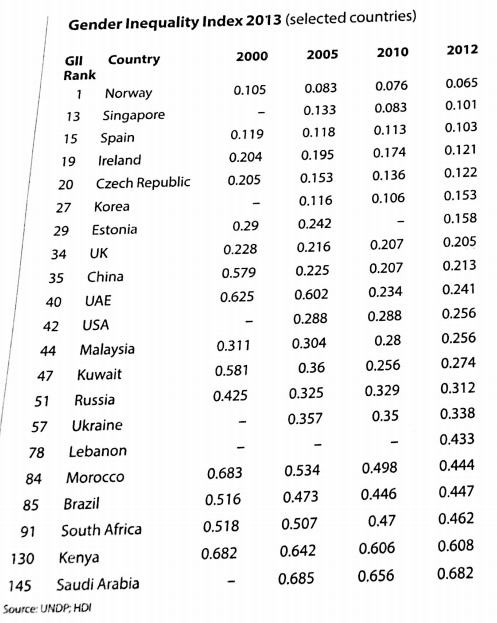
The values on the Gender Inequality Index of the three GCC countries in the Table 1
The Gender Inequality Index is the term that refers to the measure of gender inequalities, as well as the losses to human development of a particular nation caused by those. The index can take values from zero to one, where zero stands for no disparities between women and men, and one implies the total inequality. Three countries I have chosen for the analysis are the United Arab Emirates, Kuwait, and Saudi Arabia.
According to the table, the United Arab Emirates is the 40th country in the GII Ranking 2012 (the first country on this list has the lowers GII value while the last one is associated with the greatest gender inequality in the world). The GII of the UAE is 0.241. In Kuwait, the situation is slightly worse. The GII there is 0.274, and the country goes 47th on the list mentioned above. As for Saudi Arabia, it is one of the several nations located at the bottom of the GII Rank. It goes under the number 145 on the list, where the maximum number is 148. Only three more countries have higher Gender Inequality Indexes. Those are Niger (0.707), Afghanistan (0.712), and Yemen (0.747). Saudi Arabia has not gone far from those, and its GII is 0.682.
The reasons for the differences in the values of the index in the three GCC countries
First of all, differences between GIIs of these three countries are caused by divergences in values that constitute the Gender Inequality Index as such. There are three of them: reproductive health, particularly maternal mortality, empowerment, made up by the percentage of women in the parliament and the percentage of those with secondary education, and, finally, the labor market participation that is determined by the proportion of women in the labor force.
These values for the United Arab Emirates are the following: maternal mortality per a hundred thousand women is 12, the percentage of females in the parliament is 17.5%, 73 women out of a hundred have secondary education, and almost the half (43.5%) of the labor force is constituted by women. As for Kuwait, maternal mortality rate and the percentage of females in the labor force are mainly the same as those of the UAE: 14 women per 100,000 and 47% respectively. However, the ratio of women in the parliament is noticeably lower (7.7%), and that explains why the GII of Kuwait is slightly higher than the one of the UEA.
Finally, parameters that determine the GII of Saudi Arabia differ significantly. Maternal mortality in this country is rather high (24 women per 100,000), and while more than the half of women (60.5%) have secondary education, only 13% of the labor force is taken by females. Consequently, that explains why the Gender Inequality Index is so high in Saudi Arabia.
In broader terms, the differences between GIIs of these countries are caused by their cultures, religions, histories, etc. Religion is hardly an issue here since all three countries are Islamic, and their holy book does not state that females must cover all their bodies, except for the eyes. Still, the majority of the population in Saudi Arabia claim they must. Another potential reason for differences in GIIs is history.
The most significant changes in the lives of women in Kuwait and the UEA happened when these two countries discovered oil in 1950-1960. That is when females got more opportunities outside their homes and families, began to think about their own literacy and health. Nevertheless, Saudi Arabia also has its share of the world’s reserves of oil. Then, why has not it tried to expand the role of women as well? Perhaps, the point is that Saudi Arabia discovered oil twenty years earlier when none of the neighborhood countries had thought of women’s rights. Maybe this nation just needs more time to adjust to the present-day world.